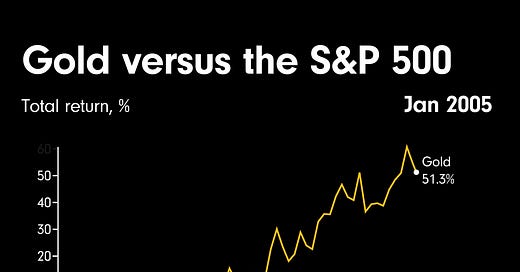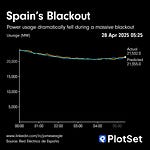If you’d told most investors 25 years ago that gold would trounce the S&P 500 in terms of total returns, they might have scoffed. After all, what does gold actually do? It pays no dividend and sits in a vault, yet somehow, over this period, it has produced eye‐watering gains that have eclipsed America’s most famous equity benchmark – the S&P 500.
That the story behind this data visualisatin, especially if you fancy yourself as an aficionado of index investing.
When I published this today, some of my followers pointed out that the starting line of 2000 was probably as a near‐perfect scenario for gold. Yes, I have to admit I cherry picked the data. The year 2000 is an emotion waypoint in my life. I often reflect back on it and wonder where the last 25 years went. It was a pivotal moment – the start of a new millenium. So, why not?
The problem is that at this point in time, the S&P 500 was entering the dotcom crash, while gold was still unloved after 20 years of lacklustre growth.
It is tempting to dismiss gold’s spectacular run since the turn of the millennium as a stroke of luck, or even cherry picking, when we trace its performance back to 2000. Yet the story of gold’s renewed appeal starts well before the dotcom bubble burst. To understand why gold has vaulted past the S&P 500 in recent years, we should look at what happened after the late 1970s and early 1980s.
Back in 1979, the stage was set for gold to shine: inflation ran rampant and interest rates soared in an attempt to bring it under control. Yet once that job was done, policymakers steered rates into a decades‐long decline in what is now called the Great Moderation. During this calmer period, gold sank out of favour because it offered no yield or obvious advantage. Equities and bonds benefitted from low inflation and a benign interest‐rate environment, and gold ended up languishing through much of the 1980s and 1990s.
That era drew to a close around 2007. The financial crisis shattered many assumptions about the perpetual resilience of equities, the invulnerability of the US dollar, and the scale of US government debt. Suddenly, gold’s strengths as a haven against currency risk and economic upheaval were back in the spotlight. Investor appetite for gold soared once more, especially as geopolitical tension and the more recent trade disputes made the metal’s protective qualities more attractive than ever.
Some still question why anyone would want to hold a non‐yielding metal. Yet the conversation around dividends often overlooks the fact that equities can be brutal in a downturn, whereas gold tends to hold its ground. Few would advise putting every penny into gold, but the case for an allocation is clearer now that inflation is creeping up again and central banks are increasingly diversifying away from the US dollar.
Looking ahead, the fundamentals that drove gold’s renaissance remain in play. Higher inflation, fractious global trade, and concerns over the level of US government debt have all eroded some of the confidence once placed in the US dollar. In that light, gold’s resilience does not seem so surprising. The real question is whether investors have learned from the past and are willing to accept that a one‐size‐fits‐all approach, focused solely on equities, can be dangerously limiting.
Perhaps the best lesson is that every market era has its winners and losers. The Great Moderation gave us decades of cheap capital and buoyant equity markets, but the post‐2007 world is not the same. And we are now arguable enter another new post-2024 era of tariffs and trade wars, led by the US.
Ignoring gold’s unique defensive qualities at this point in time risks overlooking an asset that has proved its worth more than once, and may well do so again.












Share this post